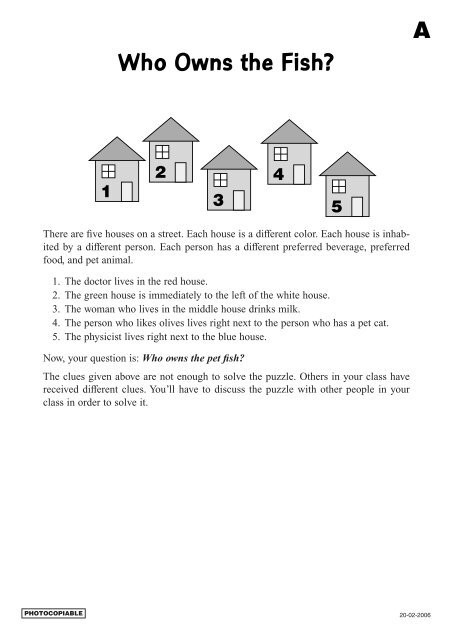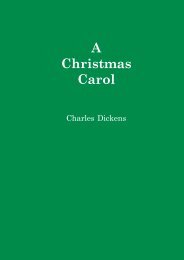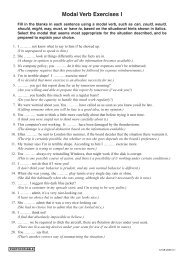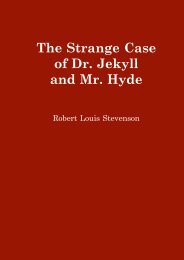Game - Who Owns the Fish Group Version.qxd
Game - Who Owns the Fish Group Version.qxd
Game - Who Owns the Fish Group Version.qxd
Create successful ePaper yourself
Turn your PDF publications into a flip-book with our unique Google optimized e-Paper software.
<strong>Who</strong> <strong>Owns</strong> <strong>the</strong> <strong>Fish</strong>?<br />
A<br />
1<br />
2<br />
3<br />
4<br />
5<br />
There are five houses on a street. Each house is a different color. Each house is inhabited<br />
by a different person. Each person has a different preferred beverage, preferred<br />
food, and pet animal.<br />
1. The doctor lives in <strong>the</strong> red house.<br />
2. The green house is immediately to <strong>the</strong> left of <strong>the</strong> white house.<br />
3. The woman who lives in <strong>the</strong> middle house drinks milk.<br />
4. The person who likes olives lives right next to <strong>the</strong> person who has a pet cat.<br />
5. The physicist lives right next to <strong>the</strong> blue house.<br />
Now, your question is: <strong>Who</strong> owns <strong>the</strong> pet fish?<br />
The clues given above are not enough to solve <strong>the</strong> puzzle. O<strong>the</strong>rs in your class have<br />
received different clues. You’ll have to discuss <strong>the</strong> puzzle with o<strong>the</strong>r people in your<br />
class in order to solve it.<br />
PHOTOCOPIABLE 20-02-2006
<strong>Who</strong> <strong>Owns</strong> <strong>the</strong> <strong>Fish</strong>?<br />
B<br />
1<br />
2<br />
3<br />
4<br />
5<br />
There are five houses on a street. Each house is a different color. Each house is inhabited<br />
by a different person. Each person has a different preferred beverage, preferred<br />
food, and pet animal.<br />
1. The firefighter has a dog.<br />
2. The inhabitant of <strong>the</strong> green house drinks coffee.<br />
3. The inhabitant of <strong>the</strong> yellow house likes onions.<br />
4. The person who has a pet horse lives right next to <strong>the</strong> person who likes onions.<br />
5. The journalist likes spinach.<br />
Now, your question is: <strong>Who</strong> owns <strong>the</strong> pet fish?<br />
The clues given above are not enough to solve <strong>the</strong> puzzle. O<strong>the</strong>rs in your class have<br />
received different clues. You’ll have to discuss <strong>the</strong> puzzle with o<strong>the</strong>r people in your<br />
class in order to solve it.<br />
PHOTOCOPIABLE 20-02-2006
<strong>Who</strong> <strong>Owns</strong> <strong>the</strong> <strong>Fish</strong>?<br />
C<br />
1<br />
2<br />
3<br />
4<br />
5<br />
There are five houses on a street. Each house is a different color. Each house is inhabited<br />
by a different person. Each person has a different preferred beverage, preferred<br />
food, and pet animal.<br />
1. The secretary prefers tea.<br />
2. The person who likes chocolates has a pet bird.<br />
3. The physicist lives in <strong>the</strong> first house.<br />
4. The person who likes peanuts drinks juice.<br />
5. The person who likes olives has an immediate neighbor who drinks water.<br />
Now, your question is: <strong>Who</strong> owns <strong>the</strong> pet fish?<br />
The clues given above are not enough to solve <strong>the</strong> puzzle. O<strong>the</strong>rs in your class have<br />
received different clues. You’ll have to discuss <strong>the</strong> puzzle with o<strong>the</strong>r people in your<br />
class in order to solve it.<br />
PHOTOCOPIABLE 20-02-2006
<strong>Who</strong> <strong>Owns</strong> <strong>the</strong> <strong>Fish</strong>?<br />
Strategy<br />
Basic Principles<br />
• For each statement in <strong>the</strong> puzzle, make a note of not only <strong>the</strong> possibilities that are confirmed by <strong>the</strong> statement,<br />
but also those that are eliminated. For example, statement 9 says that <strong>the</strong> physicist lives in <strong>the</strong> first<br />
house. This statement not only confirms <strong>the</strong> presence of <strong>the</strong> physicist in <strong>the</strong> first house (transforming it from<br />
a mere possibility to a certainty), but it also eliminates <strong>the</strong> possibility of <strong>the</strong> physicist living in any o<strong>the</strong>r<br />
house, and it eliminates <strong>the</strong> possibility of anyone else living in <strong>the</strong> first house. The possibilities that are<br />
eliminated by each statement are just as important as <strong>the</strong> possibilities that are confirmed.<br />
• Be sure to examine all possibilities for every statement, and carefully mark any possibilities that are eliminated.<br />
If at any point only one of five possibilities exists, <strong>the</strong>n that possibility is confirmed. For example,<br />
if <strong>the</strong> possibility of a given person living in houses 1, 2, 3 or 4 has been eliminated, <strong>the</strong>n that person must<br />
live in house 5.<br />
• Periodically double-check for possibilities that have been eliminated by all <strong>the</strong> statements considered thus<br />
far.<br />
• Use a worksheet (such as <strong>the</strong> one included with this exercise) to simplify tracking of possibilities.<br />
Using <strong>the</strong> Worksheet<br />
• The worksheet contains a number of grids, representing <strong>the</strong> correspondence between occupations and<br />
houses, colors and houses, animals and houses, beverages and houses, and so on. Each box in each grid<br />
represents a possibility. For example, <strong>the</strong> box at <strong>the</strong> intersection of physicist and 1 represents <strong>the</strong> possibility<br />
that <strong>the</strong> physicist lives in house 1.<br />
• If a box in a grid is blank, it means that <strong>the</strong> possibility it represents has been nei<strong>the</strong>r confirmed nor eliminated.<br />
If <strong>the</strong> box contains an O, it means that <strong>the</strong> possibility has been confirmed. If <strong>the</strong> box contains an X,<br />
it means that <strong>the</strong> possibility has been eliminated.<br />
• Mark a O in <strong>the</strong> box representing a possibility whenever a statement confirms that possibility. Then mark<br />
X’s in all of <strong>the</strong> boxes in <strong>the</strong> corresponding row and column of that grid (since confirming <strong>the</strong> one possibility<br />
eliminates all related possibilities).<br />
• If a row or column contains only one blank box with X’s in every o<strong>the</strong>r box, mark an O in <strong>the</strong> blank box,<br />
since it is <strong>the</strong> only remaining possibility and is thus confirmed.<br />
• Be sure to check all <strong>the</strong> grids periodically for possibilities that have been recently eliminated, based on<br />
changes in o<strong>the</strong>r grids.<br />
• As each grid fills, <strong>the</strong>re should be exactly one and only one O in each row and one O in each column, and<br />
no blank boxes. When all grids are full, you’ll have <strong>the</strong> solution to <strong>the</strong> puzzle.<br />
<strong>Group</strong> <strong>Version</strong> Note<br />
• Each group receives only one third of all available clues.<br />
• You must communicate with people in o<strong>the</strong>r groups in order to solve <strong>the</strong> puzzle.<br />
• Avoid simply reciting clues to each o<strong>the</strong>r.<br />
PHOTOCOPIABLE 20-02-2006
1 2 3 4 5<br />
1 2 3 4 5<br />
doctor<br />
red<br />
physicist<br />
blue<br />
firefighter<br />
green<br />
secretary<br />
yellow<br />
journalist<br />
white<br />
1 2 3 4 5<br />
1 2 3 4 5<br />
fish<br />
spinach<br />
horse<br />
peanuts<br />
cat<br />
chocolates<br />
dog<br />
olives<br />
bird<br />
onions<br />
1 2 3 4 5<br />
water<br />
juice<br />
coffee<br />
tea<br />
milk<br />
milk<br />
spinach<br />
coffee<br />
peanuts<br />
tea<br />
chocolates<br />
water<br />
olives<br />
juice<br />
onions<br />
red<br />
green<br />
blue<br />
yellow<br />
white<br />
fish<br />
dog<br />
bird<br />
horse<br />
cat<br />
doctor<br />
journalist<br />
secretary<br />
firefighter<br />
physicist<br />
doctor<br />
journalist<br />
secretary<br />
firefighter<br />
physicist<br />
PHOTOCOPIABLE 20-02-2006
<strong>Who</strong> <strong>Owns</strong> <strong>the</strong> <strong>Fish</strong>?<br />
Solution<br />
1 2 3 4 5<br />
yellow<br />
physicist<br />
onions<br />
water<br />
cat<br />
blue<br />
secretary<br />
olives<br />
tea<br />
horse<br />
red<br />
doctor<br />
chocolates<br />
milk<br />
bird<br />
green<br />
journalist<br />
spinach<br />
coffee<br />
fish<br />
white<br />
firefighter<br />
peanuts<br />
juice<br />
dog<br />
The pet fish belongs to <strong>the</strong> journalist.<br />
The first house is yellow. It is occupied by a physicist who<br />
likes onions and drinks water. He has a pet cat.<br />
The second house is blue and it is occupied by a secretary<br />
who likes olives and drinks tea. She has a pet horse.<br />
The third house is red and its occupant is a doctor who likes<br />
chocolates and drinks milk. She has a pet bird.<br />
The fourth house is green and is occupied by a journalist. He<br />
likes spinach and drinks coffee. He has a pet fish.<br />
The fifth house is white and its occupant is a firefighter. She<br />
likes peanuts and drinks juice. She has a pet dog.<br />
PHOTOCOPIABLE 20-02-2006
1 2 3 4 5<br />
1 2 3 4 5<br />
doctor<br />
red<br />
physicist<br />
blue<br />
firefighter<br />
green<br />
secretary<br />
yellow<br />
journalist<br />
white<br />
1 2 3 4 5<br />
1 2 3 4 5<br />
fish<br />
spinach<br />
horse<br />
peanuts<br />
cat<br />
chocolates<br />
dog<br />
olives<br />
bird<br />
onions<br />
1 2 3 4 5<br />
water<br />
juice<br />
coffee<br />
tea<br />
milk<br />
milk<br />
spinach<br />
coffee<br />
peanuts<br />
tea<br />
chocolates<br />
water<br />
olives<br />
juice<br />
onions<br />
red<br />
green<br />
blue<br />
yellow<br />
white<br />
fish<br />
dog<br />
bird<br />
horse<br />
cat<br />
doctor<br />
journalist<br />
secretary<br />
firefighter<br />
physicist<br />
doctor<br />
journalist<br />
secretary<br />
firefighter<br />
physicist<br />
PHOTOCOPIABLE 20-02-2006
Objective<br />
<strong>Who</strong> <strong>Owns</strong> <strong>the</strong> <strong>Fish</strong>?<br />
Teacher’s Guide - <strong>Group</strong> <strong>Version</strong><br />
• The objective of this puzzle exercise is to force students to speak and (hopefully) think in English while<br />
solving a complex problem in logic. Most people find it extremely difficult to solve logic problems and<br />
speak and understand a foreign language at <strong>the</strong> same time, so this exercise forces students to use <strong>the</strong>ir<br />
brains much more than it might at first appear.<br />
General Suggestions<br />
• Give each person in <strong>the</strong> class a copy of <strong>the</strong> A, B, or C sheet of clues. If <strong>the</strong>re are only two students in <strong>the</strong><br />
class, you might want to use <strong>the</strong> third sheet of clues yourself.<br />
• How you divide <strong>the</strong> clue sheets up among <strong>the</strong> class is your decision, but it might be best to divide <strong>the</strong>m so<br />
that students are forced to speak out loud to each o<strong>the</strong>r in order to share clues (this allows you to make sure<br />
that <strong>the</strong>y are speaking English when <strong>the</strong>y do so).<br />
• The Strategy sheet is optional, as are <strong>the</strong> worksheets. These sheets help students to solve <strong>the</strong> puzzle, but<br />
<strong>the</strong>y are only incidental to <strong>the</strong> goal of getting <strong>the</strong>m to use English. Hand <strong>the</strong>m out if you think <strong>the</strong> students<br />
will need <strong>the</strong> help. The Strategy sheet explains some general principles for solving this type of problem and<br />
suggests a method for using <strong>the</strong> worksheets. The worksheets <strong>the</strong>mselves are handy for helping students to<br />
organize information <strong>the</strong>y obtain by examining and sharing clues.<br />
• Make sure students speak English while solving <strong>the</strong> puzzle; <strong>the</strong> urge to slip back into one’s native language<br />
when solving difficult problems is often irresistible.<br />
• To force students to speak and understand English, ask <strong>the</strong>m questions, and if <strong>the</strong>y have answers to <strong>the</strong><br />
questions, ask <strong>the</strong>m to explain how <strong>the</strong>y logically arrived at those answers. For example, you can ask<br />
“Which house is blue?” and students should reply with “The second house.” Then ask <strong>the</strong>m how <strong>the</strong>y concluded<br />
that <strong>the</strong> second house is blue, and <strong>the</strong> answer should be along <strong>the</strong> lines of “The blue house is next<br />
to <strong>the</strong> house where <strong>the</strong> physicist lives, and <strong>the</strong> physicist lives in <strong>the</strong> first house.”<br />
• Students may not solve <strong>the</strong> puzzle before <strong>the</strong> end of <strong>the</strong> class. You can give it as homework, or save it and<br />
resume work during <strong>the</strong> next class, or simply give <strong>the</strong>m <strong>the</strong> solution before <strong>the</strong>y leave. It’s up to you. Some<br />
students will be frustrated if <strong>the</strong>y leave without solving <strong>the</strong> puzzle; on <strong>the</strong> o<strong>the</strong>r hand, o<strong>the</strong>r students may<br />
be peeved if <strong>the</strong>y are given <strong>the</strong> solution before <strong>the</strong>y’ve worked it all out for <strong>the</strong>mselves. Remember that <strong>the</strong><br />
goal is to make <strong>the</strong>m use English, not to get solutions to <strong>the</strong> puzzle.<br />
Observations and Tips<br />
• Some students will assume that a doctor or firefig<strong>the</strong>r cannot be female, and may reach incorrect conclusions<br />
on this basis.<br />
• Make sure that students understand which items are food, and which are drink. For example, students must<br />
understand that chocolates are food, not drink (some may confuse chocolates with hot chocolate as a beverage).<br />
• During World War II, some Nazi spies spoke perfect English. In order to determine whe<strong>the</strong>r a suspected<br />
spy really had English as his native language or not, one test was to ask <strong>the</strong> suspected spy to solve a math<br />
problem on a blackboard and explain his work as he went, in English. Spies would often slip into German<br />
while solving <strong>the</strong> problem and thus betray <strong>the</strong>mselves. This illustrates how hard it is to solve a logic problem<br />
and speak a foreign language at <strong>the</strong> same time. But it’s great practice.<br />
PHOTOCOPIABLE 20-02-2006





